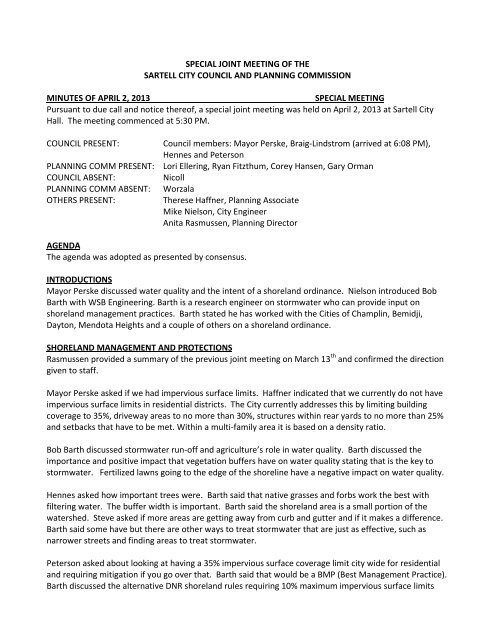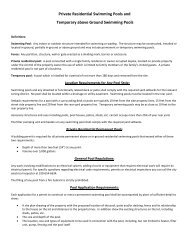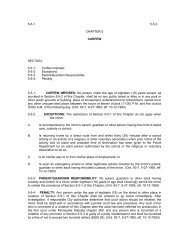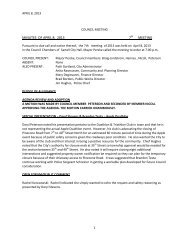Minutes - City of Sartell
Minutes - City of Sartell
Minutes - City of Sartell
Create successful ePaper yourself
Turn your PDF publications into a flip-book with our unique Google optimized e-Paper software.
SPECIAL JOINT MEETING OF THE<br />
SARTELL CITY COUNCIL AND PLANNING COMMISSION<br />
MINUTES OF APRIL 2, 2013<br />
SPECIAL MEETING<br />
Pursuant to due call and notice there<strong>of</strong>, a special joint meeting was held on April 2, 2013 at <strong>Sartell</strong> <strong>City</strong><br />
Hall. The meeting commenced at 5:30 PM.<br />
COUNCIL PRESENT:<br />
PLANNING COMM PRESENT:<br />
COUNCIL ABSENT:<br />
PLANNING COMM ABSENT:<br />
OTHERS PRESENT:<br />
Council members: Mayor Perske, Braig-Lindstrom (arrived at 6:08 PM),<br />
Hennes and Peterson<br />
Lori Ellering, Ryan Fitzthum, Corey Hansen, Gary Orman<br />
Nicoll<br />
Worzala<br />
Therese Haffner, Planning Associate<br />
Mike Nielson, <strong>City</strong> Engineer<br />
Anita Rasmussen, Planning Director<br />
AGENDA<br />
The agenda was adopted as presented by consensus.<br />
INTRODUCTIONS<br />
Mayor Perske discussed water quality and the intent <strong>of</strong> a shoreland ordinance. Nielson introduced Bob<br />
Barth with WSB Engineering. Barth is a research engineer on stormwater who can provide input on<br />
shoreland management practices. Barth stated he has worked with the Cities <strong>of</strong> Champlin, Bemidji,<br />
Dayton, Mendota Heights and a couple <strong>of</strong> others on a shoreland ordinance.<br />
SHORELAND MANAGEMENT AND PROTECTIONS<br />
Rasmussen provided a summary <strong>of</strong> the previous joint meeting on March 13 th and confirmed the direction<br />
given to staff.<br />
Mayor Perske asked if we had impervious surface limits. Haffner indicated that we currently do not have<br />
impervious surface limits in residential districts. The <strong>City</strong> currently addresses this by limiting building<br />
coverage to 35%, driveway areas to no more than 30%, structures within rear yards to no more than 25%<br />
and setbacks that have to be met. Within a multi-family area it is based on a density ratio.<br />
Bob Barth discussed stormwater run-<strong>of</strong>f and agriculture’s role in water quality. Barth discussed the<br />
importance and positive impact that vegetation buffers have on water quality stating that is the key to<br />
stormwater. Fertilized lawns going to the edge <strong>of</strong> the shoreline have a negative impact on water quality.<br />
Hennes asked how important trees were. Barth said that native grasses and forbs work the best with<br />
filtering water. The buffer width is important. Barth said the shoreland area is a small portion <strong>of</strong> the<br />
watershed. Steve asked if more areas are getting away from curb and gutter and if it makes a difference.<br />
Barth said some have but there are other ways to treat stormwater that are just as effective, such as<br />
narrower streets and finding areas to treat stormwater.<br />
Peterson asked about looking at having a 35% impervious surface coverage limit city wide for residential<br />
and requiring mitigation if you go over that. Barth said that would be a BMP (Best Management Practice).<br />
Barth discussed the alternative DNR shoreland rules requiring 10% maximum impervious surface limits
and the current limit at 25%. Rasmussen discussed the need for balance and that a 10% limit would result<br />
in larger lots. Some would argue that urban sprawl is not good. Nielson recommended adopted an<br />
impervious surface limit in residential districts. Mayor Perske said he was concerned with run<strong>of</strong>f along<br />
shorelines. Ellering said a trade <strong>of</strong>f would be to require buffers.<br />
The MS4 permit requirements were discussed. Barth said that the MS4 permit addresses impaired waters<br />
and that should not be included in a shoreland ordinance.<br />
Fitzthum asked about determining the amount <strong>of</strong> mitigation needed. Barth said it depends on the size <strong>of</strong><br />
the lot but it could be having a buffer a certain width along the shoreline.<br />
There was discussion on having a higher city wide impervious surface limit. Barth recommended having a<br />
flexible standard and the benefit <strong>of</strong> being denser. Up to 40% can be mitigated well. The problem with<br />
urban sprawl is there is a lot more exposure to fertilizer resulting in phosphorus problems within our<br />
waterways. Fitzthum suggested the shoreland area be 30%-35% for single-family residential areas.<br />
Lindstrom discussed past development not considering these issues. Hansen said he agreed with having<br />
standards but that it could not be so restrictive that it creates development problems. Lindstrom<br />
discussed how to deal with a small house surrounded by larger houses, therefore, not fitting the character<br />
<strong>of</strong> the neighborhood. Ellering recommended an impervious surface limit <strong>of</strong> 30% in shoreland areas for<br />
single-family and two-family residential areas and 40% city wide for single-family and two-family<br />
residential areas. Peterson said he agreed with Ellering.<br />
Consensus was to limit impervious surface coverage in single-family and two family residential areas to<br />
30% in shoreland areas within 100 feet and 40% in single-family and two-family residential areas city<br />
wide.<br />
Haffner asked about multi-family impervious surface limits and discussed what other communities have in<br />
place. Nielson discussed the lack <strong>of</strong> space for stormwater pond needs. Haffner shared that landscaping<br />
space was a concern as well and suggested requiring at least 50% greenspace for multi-family areas.<br />
There was discussion on wetland areas being counted as greenspace. Consensus was to discuss this<br />
further at the next meeting and look at net buildable area.<br />
ADJOURNMENT<br />
Perske adjourned the meeting at 7:01 pm.<br />
<strong>Minutes</strong> By:<br />
___________________________________<br />
Therese Haffner, Planning Associate<br />
__________________________________<br />
Joe Perske, Mayor





